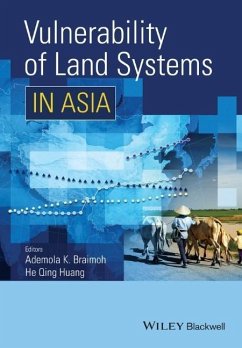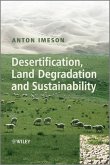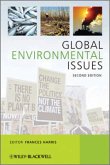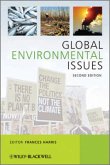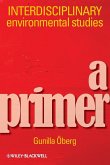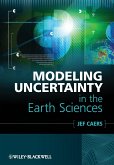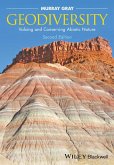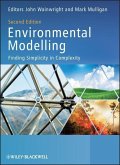- Gebundenes Buch
- Merkliste
- Auf die Merkliste
- Bewerten Bewerten
- Teilen
- Produkt teilen
- Produkterinnerung
- Produkterinnerung
This book provides a comprehensive yet accessible overview of land systems vulnerability assessment in Asia - fundamental to the understanding of the link between global change, environmental sustainability and human wellbeing. The extent and intensity of human interactions with the environment have increased spectacularly since the Industrial Revolution. Thus, the global change research community and development practitioners increasingly recognize the need to address the adverse consequences of changes taking place in the structure and function of the biosphere and the implications for…mehr
Andere Kunden interessierten sich auch für
![Desertification, Land Degradation and Sustainability Desertification, Land Degradation and Sustainability]() Anton ImesonDesertification, Land Degradation and Sustainability118,99 €
Anton ImesonDesertification, Land Degradation and Sustainability118,99 €![Global Environmental Issues Global Environmental Issues]() Global Environmental Issues90,99 €
Global Environmental Issues90,99 €![Global Environmental Issues Global Environmental Issues]() Global Environmental Issues172,99 €
Global Environmental Issues172,99 €![Interdisciplinary Environmental Studies Interdisciplinary Environmental Studies]() Gunilla ObergInterdisciplinary Environmental Studies70,99 €
Gunilla ObergInterdisciplinary Environmental Studies70,99 €![Modeling Uncertainty in the Earth Sciences Modeling Uncertainty in the Earth Sciences]() Jef CaersModeling Uncertainty in the Earth Sciences89,99 €
Jef CaersModeling Uncertainty in the Earth Sciences89,99 €![Geodiversity Geodiversity]() Murray GrayGeodiversity174,99 €
Murray GrayGeodiversity174,99 €![Environmental Modelling Environmental Modelling]() Environmental Modelling156,99 €
Environmental Modelling156,99 €-
-
-
This book provides a comprehensive yet accessible overview of land systems vulnerability assessment in Asia - fundamental to the understanding of the link between global change, environmental sustainability and human wellbeing. The extent and intensity of human interactions with the environment have increased spectacularly since the Industrial Revolution. Thus, the global change research community and development practitioners increasingly recognize the need to address the adverse consequences of changes taking place in the structure and function of the biosphere and the implications for society. With a focus on Asia, this book provides an overview of the vulnerability of land systems and the subsequent multiple stressors in this region. The book offers a discussion surrounding the potential causal processes that affect land systems vulnerability and our capacity to cope with different perturbations. It also identifies factors that help to integrate vulnerability assessment into policy and decision-making.
- Addresses the complex issues arising from human-environment interactions that cannot be satisfactorily dealt with by core disciplinary methods alone.
- Key coverage of a variety of topics from the vulnerability of smallholder agriculture and urban systems to the impact of socioeconomic processes at the sub-regional level.
- Coverage of the causal processes that affect land systems vulnerability and capacity to cope with different perturbations are documented.
- Focus on integrating vulnerability assessment into policies and decision-making
- Includes contributions from leading academics in the field.
Hinweis: Dieser Artikel kann nur an eine deutsche Lieferadresse ausgeliefert werden.
- Addresses the complex issues arising from human-environment interactions that cannot be satisfactorily dealt with by core disciplinary methods alone.
- Key coverage of a variety of topics from the vulnerability of smallholder agriculture and urban systems to the impact of socioeconomic processes at the sub-regional level.
- Coverage of the causal processes that affect land systems vulnerability and capacity to cope with different perturbations are documented.
- Focus on integrating vulnerability assessment into policies and decision-making
- Includes contributions from leading academics in the field.
Hinweis: Dieser Artikel kann nur an eine deutsche Lieferadresse ausgeliefert werden.
Produktdetails
- Produktdetails
- Verlag: Wiley & Sons
- 1. Auflage
- Seitenzahl: 368
- Erscheinungstermin: 17. November 2014
- Englisch
- Abmessung: 244mm x 170mm x 23mm
- Gewicht: 862g
- ISBN-13: 9781118854952
- ISBN-10: 1118854950
- Artikelnr.: 41521934
- Herstellerkennzeichnung
- Libri GmbH
- Europaallee 1
- 36244 Bad Hersfeld
- gpsr@libri.de
- Verlag: Wiley & Sons
- 1. Auflage
- Seitenzahl: 368
- Erscheinungstermin: 17. November 2014
- Englisch
- Abmessung: 244mm x 170mm x 23mm
- Gewicht: 862g
- ISBN-13: 9781118854952
- ISBN-10: 1118854950
- Artikelnr.: 41521934
- Herstellerkennzeichnung
- Libri GmbH
- Europaallee 1
- 36244 Bad Hersfeld
- gpsr@libri.de
Dr Ademola K. Braimoh Senior Natural Resources Management Specialist, The World Bank Prof. He Qing Huang Institute of Geographic Sciences and Natural Resources Research, Chinese Academy of Sciences
Editors' Introductions xiii
List of Contributors xv
Preface xix
1 Land Systems Vulnerability 1
Ademola K. Braimoh and He Qing Huang
1.1 Introduction 1
1.2 Overview of the book 3
Acknowledgements 5
References 5
Part I Hazards and Vulnerability
2 Drought and Extreme Climate Stress on Human-Environment Systems in the
Gobi Desert Mongolia 11
Troy Sternberg
2.1 Introduction 11
2.1.1 Social ecological systems 12
2.1.2 Mongolian rangelands 13
2.2 Methods 14
2.2.1 Study area 14
2.2.2 Methodology 14
2.3 Results 15
2.3.1 Spatial continuity of droughts 15
2.3.2 Dzud of 1999-2001 16
2.3.3 Dzud and drought: non-drought years 17
2.4 Discussion 19
2.4.1 Resilience 20
2.5 Conclusion 22
Acknowledgements 22
References 22
3 Vulnerability and Resilience of the Mongolian Pastoral Social-Ecological
Systems to Multiple Stressors 27
Dennis Ojima, Togtokh Chuluun and Myagmarsuren Altanbagana
3.1 Introduction 27
3.2 The current situation 29
3.2.1 Climate conditions 29
3.2.2 Water resources 30
3.2.3 The nomadic system 31
3.2.4 Livestock changes 31
3.3 Analysis of vulnerability of critical ecosystem services 32
3.3.1 Vulnerability index of pastoral systems 32
3.3.2 Integrated zud index 32
3.3.3 Rangeland use index 33
3.3.4 Assessment of rangeland vulnerability to climate and land-use changes
34
3.4 Coping scenarios 34
3.5 Summary and conclusion 37
3.5.1 A win-win model 38
Acknowledgements 38
References 39
4 Vulnerability of Pastoral Communities in Central Mongolia to Climate and
Land-Use Changes 41
T. Chuluun, M. Altanbagana, S. Davaanyam, B. Tserenchunt and D. Ojima
4.1 Introduction 41
4.2 Study sites and methodology 43
4.3 Research results 45
4.4 The results of a social survey related to the 'dryland development
paradigm' 46
4.5 Pastoral social-ecological scenarios 49
4.6 Policy-related social survey 56
4.7 Discussion 59
4.8 Conclusion 60
Acknowledgements 61
References 61
5 Vulnerability Assessment Diagram: A Case Study on Drought in Middle Inner
Mongolia, China 63
Xiaoqian Liu, He Yin and Ademola K. Braimoh
5.1 Introduction 63
5.2 An integrated diagram for vulnerability assessment: the VSD model 64
5.3 Case study using the VSD model 66
5.3.1 The study area 66
5.3.2 Vulnerability profile at the county level 67
5.4 Results and discussion 69
5.4.1 Relative impact of the components on the vulnerability index 69
5.4.2 Model calibration 71
5.5 Conclusion 72
References 74
6 Vulnerability of Agriculture to Climate Change in Arid Regions: a Case
Study of Western Rajasthan, India 77
R.B. Singh and Ajay Kumar
6.1 Introduction 77
6.2 Climate change scenarios: global, national and local levels 78
6.3 Study area 80
6.4 Research methodology 80
6.5 Results and discussions 82
6.5.1 Climate variability 82
6.5.2 Vulnerability assessment 82
6.5.3 Vulnerability 86
6.6 Conclusion 89
References 89
7 Dendrogeomorphological and Sedimentological Analysis of Debris Flow
Hazards in the Northern Zailiiskiy Alatau, Tien Shan Mountains, Kazakhstan
91
Vanessa Winchester, David G. Passmore, Stephan Harrison, Alaric Rae, Igor
Severskiy and Nina V. Pimankina
7.1 Introduction 91
7.2 Study area 93
7.3 Methods and materials 93
7.3.1 Geomorphology and sedimentology 93
7.3.2 Archive datasets 96
7.3.3 Dendrogeomorphology 96
7.3.4 Cross-dating, reference series identification and skeleton plotting
96
7.3.5 Seedling establishment, growth rates below coring height and
earthquakes 99
7.4 Results 100
7.4.1 Growth rate and establishment periods 100
7.4.2 Kumbelsu Creek 102
7.4.3 Sedimentology, geomorphology and dating of fluvial terraces, fans and
debris flows in the Ozernaya valley 102
7.4.4 Debris flow events in the Ozernaya Valley and archival records 104
7.5 Discussion 107
7.6 Conclusions 110
Acknowledgements 111
References 111
Part II Land-use Change: Modelling and Impact Assessment
8 Regional Scenarios and Simulated Land-Cover Changes in Montane Mainland
Southeast Asia 117
Jefferson Fox, John B. Vogler, Omer L. Sen, Alan L. Ziegler and Thomas W.
Giambelluca
8.1 Introduction 117
8.2 Methods 119
8.2.1 Baseline land-cover classification 120
8.2.2 CLUE-s model 121
8.2.3 Land-cover allocation 129
8.3 Results 129
8.4 Discussion and conclusions 135
Acknowledgements 138
References 138
9 Land-use Change and its Impacts on Agricultural Productivity in China 143
Huimin Yan, He Qing Huang, Xiangzheng Deng and Jiyuan Liu
9.1 Introduction 143
9.2 Land-use data 144
9.3 Methods for estimating changes in agricultural productivity 145
9.3.1 NPP estimation with the GLO-PEM model 145
9.3.2 Agro-ecological zones (AEZ) model 146
9.3.3 Calculating agricultural productivity change caused by land use
change 146
9.4 Agricultural productivity change caused by cropland transformation 147
9.4.1 Cropland transformation 147
9.4.2 Contributions of cropland area change to agricultural productivity
148
9.4.3 Agricultural productivity change caused by major land use change
types 150
9.4.4 Changes in potential agricultural productivity due to cropland
conversions 151
9.5 Summary 152
Acknowledgements 152
References 152
10 Long-Term Land-Cover Change in the Amur River Basin 155
Shigeko Haruyama, Yoshitaka Masuda and Akihiko Kondoh
10.1 Introduction 155
10.2 Outline of study area 156
10.3 The dataset 157
10.3.1 NOAA/AVHRR PAL dataset 157
10.3.2 Statistical materials used in the agricultural and field
investigation 157
10.4 Method of study 158
10.4.1 Analysis of secular variation from 1982 to 2000 158
10.5 Results and consideration 159
10.5.1 Analysis of secular variation in land cover from 1982 to 2000 159
10.5.2 Verification of validity of PAL data analysis 162
10.6 Summary 163
Acknowledgements 163
References 163
11 Simulating Land-use Change in China from a Global Perspective 165
Xuefeng Cui, Mark Rounsevell, Yuan Jiang, Muyi Kang, Paul Palmer, Wen Chen
and Terence Dawson
11.1 Introduction 165
11.2 Land use in China 166
11.3 Global perspectives 168
11.4 Model and data 170
11.5 Model results 171
11.5.1 Historical simulation 171
11.5.2 Future 'business as usual' scenario 173
11.6 Discussion and conclusions 176
Acknowledgements 176
References 176
12 Sustainable Land Use Planning in West Asia Using MicroLEIS Decision
Support Systems 179
Farzin Shahbazi, Maria Anaya-Romero, Ademola K. Braimoh and Diego De la
Rosa
12.1 Introduction 179
12.2 Materials and methods 181
12.2.1 Study area 181
12.2.2 Climate 181
12.2.3 Benchmark soils 181
12.2.4 The MicroLEIS technology 183
12.3 Modelling with MicroLEIS in the Ahar region 185
12.3.1 Arable land identification 185
12.3.2 Semi-natural habitats 186
12.3.3 Crop diversification 187
12.3.4 Soil productivity capability evaluation 190
12.3.5 Soil fertility capability evaluation 191
12.4 Conclusions 191
Acknowledgements 193
References 193
13 Impacts of Agricultural Land Change on Biodiversity and Ecosystem
Services in Kahayan Watershed, Central Kalimantan 195
J.S. Rahajoe, L. Alhamd, E.B. Walujo, H.S. Limin, M.S. Suneetha, A.K.
Braimoh and T. Kohyama
13.1 Introduction 195
13.2 Study locations and methods 197
13.2.1 Study sites: Bawan village, Central Kalimantan 197
13.2.2 Participatory rural appraisal 200
13.3 Results and discussion 200
13.3.1 Current status of the Kahayan watershed 200
13.3.2 Biodiversity and forest products in Bawan village 201
13.3.3 Ecosystem services in Bawan village 206
13.3.4 Rubber plantations in Bawan village 206
13.3.5 Changes in farming systems and agricultural produce 210
13.4 Conclusion 212
Acknowledgements 212
References 212
14 Spatio-Temporal Evolution of Urban Structure in Shanghai 215
Wenze Yue, Peilei Fan and Jiaguo Qi
14.1 Introduction 215
14.2 Theoretical framework, study area, data, and methodology 216
14.2.1 Theoretical framework 216
14.2.2 Study area 218
14.2.3 Data and methodology 219
14.3 Findings 219
14.3.1 Urban evolution of Shanghai 219
14.3.2 Urban transformation at the district level 222
14.4 Discussion 226
14.4.1 Economic restructuring and globalization 227
14.4.2 Changing population profile and impact on the housing market 228
14.4.3 The role of the multi-scaled state 229
14.5 Conclusion 230
Acknowledgements 232
References 232
Part III Institutions
15 Governing Ecosystem Services from Upland Watersheds in Southeast Asia
237
Louis Lebel and Rajesh Daniel
15.1 Introduction 237
15.2 Plans 238
15.2.1 Protected areas 238
15.2.2 Forest and watershed classifications 239
15.2.3 Participatory land-use planning 241
15.3 Rules 242
15.3.1 Property rights and land tenure 242
15.3.2 Community-based management 243
15.3.3 Logging concessions 244
15.3.4 Logging bans 245
15.4 Incentives 246
15.4.1 Payments for ecosystem services 246
15.4.2 Certification 248
15.5 Information 249
15.6 Discussion 250
15.7 Conclusions 252
Acknowledgements 253
References 253
16 Socio-Economic Impacts of a Wetland Restoration Program in China's
Poyang Lake Region 261
Fen Li, Lin Zhen, He Qing Huang, Yunjie Wei, Li Yang and Sandra Uthes
16.1 Introduction 261
16.2 Study area 263
16.2.1 Background 263
16.3 Methods 264
16.3.1 Analysis of land use and economic data 264
16.3.2 Stakeholder analysis 264
16.3.3 Household surveys 265
16.3.4 Farmers' willingness to accept eco-compensation (WTA) 265
16.3.5 Estimation of the eco-compensation burden of the local governments
266
16.4 Results 267
16.4.1 Land use changes 267
16.4.2 Changes in the economic structure 268
16.4.3 Stakeholder groups 269
16.4.4 Farmers' willingness to accept eco-compensation 270
16.4.5 Eco-compensation burden of the local governments 272
16.5 Discussion 272
16.6 Conclusions 274
Acknowledgements 275
References 275
17 China's Sloping Land Conversion Program: Are the Farmers Paid Enough?
277
Shubhechchha Thapa, Xing Lu and Ademola K. Braimoh
17.1 Introduction 277
17.2 The study area 278
17.3 Data sources and analysis 279
17.4 Results and discussion 280
17.4.1 Quantitative data on land-cover change 280
17.4.2 Carbon dynamics in the landscape 281
17.4.3 Landscape value 281
17.5 Conclusion 282
References 283
18 Community-Based Peatland Management for Greenhouse Gas Reduction Based
on Fire-Free Land Preparation 285
Bambang Hero Saharjo
18.1 Introduction 285
18.2 Greenhouse gas emissions 286
18.2.1 Southeast Asian greenhouse gases emissions 286
18.2.2 Indonesian greenhouse gas emissions 287
18.3 The current Indonesian forest fire situation 289
18.4 Greenhouse gas emissions reduction 290
18.4.1 Smoke management 290
18.4.2 Greenhouse gas emission reduction through land preparation without
fire: an example from the community 291
18.4.3 Peatland management and restoration of organic soils 295
18.5 Conclusion 295
Acknowledgements 295
References 296
19 Structuring Climate Finance for Adaptation Measures in Vulnerable
Ecosystems: Lessons from India 297
A. Damodaran
19.1 Introduction 297
19.2 Approach 298
19.3 Methodology of field studies 298
19.4 Co-benefits approach to adaptation financing and equity 299
19.5 Adaptation gradients 301
19.6 Adaptation possibility trends for agro and coastal ecosystems:
preliminary assessment 302
19.7 Financing systems for adaptation to climate change 303
19.8 Evidence from the study area 306
19.9 Lessons and implications: summing up 307
References 308
20 Scientific Uncertainty and Policy Making: How can Communications
Contribute to a Better Marriage in the Global Change Arena? 311
Gabriela Litre
20.1 A case study: the establishment of marine reserves off the Californian
coast 312
20.2 A matter of trust 313
20.3 Communicating scientific uncertainty 315
20.3.1 Quantifying uncertainties 315
20.3.2 Communicating the quantified uncertainties 316
20.4 The need for a new language 316
20.5 Changing worlds 317
20.6 A learning experience 318
Acknowledgements 319
References 319
21 Planning for Resilience: the Quest for Learning and Adaptation 323
Fernando Teigao dos Santos
21.1 Introductory insights 323
21.2 The global 'carousel' context 324
21.3 Looking at the resilience framework 325
21.4 Planning for resilience 328
21.5 'Command-and-control' vs 'learning-and-adaptation' 329
21.6 The strategic SPARK example 331
21.7 Final considerations 332
Acknowledgements 333
References 333
22 Conclusion 337
He Qing Huang and Ademola K. Braimoh
22.1 Improving understanding in areas lacking data 337
22.2 Highlighting the effects of scale 339
22.3 Validating the conceptual framework for vulnerability assessment 339
22.4 Land system vulnerability in other parts of the world 339
22.5 Roads ahead 340
22.6 Final remarks 341
References 341
Index 343
List of Contributors xv
Preface xix
1 Land Systems Vulnerability 1
Ademola K. Braimoh and He Qing Huang
1.1 Introduction 1
1.2 Overview of the book 3
Acknowledgements 5
References 5
Part I Hazards and Vulnerability
2 Drought and Extreme Climate Stress on Human-Environment Systems in the
Gobi Desert Mongolia 11
Troy Sternberg
2.1 Introduction 11
2.1.1 Social ecological systems 12
2.1.2 Mongolian rangelands 13
2.2 Methods 14
2.2.1 Study area 14
2.2.2 Methodology 14
2.3 Results 15
2.3.1 Spatial continuity of droughts 15
2.3.2 Dzud of 1999-2001 16
2.3.3 Dzud and drought: non-drought years 17
2.4 Discussion 19
2.4.1 Resilience 20
2.5 Conclusion 22
Acknowledgements 22
References 22
3 Vulnerability and Resilience of the Mongolian Pastoral Social-Ecological
Systems to Multiple Stressors 27
Dennis Ojima, Togtokh Chuluun and Myagmarsuren Altanbagana
3.1 Introduction 27
3.2 The current situation 29
3.2.1 Climate conditions 29
3.2.2 Water resources 30
3.2.3 The nomadic system 31
3.2.4 Livestock changes 31
3.3 Analysis of vulnerability of critical ecosystem services 32
3.3.1 Vulnerability index of pastoral systems 32
3.3.2 Integrated zud index 32
3.3.3 Rangeland use index 33
3.3.4 Assessment of rangeland vulnerability to climate and land-use changes
34
3.4 Coping scenarios 34
3.5 Summary and conclusion 37
3.5.1 A win-win model 38
Acknowledgements 38
References 39
4 Vulnerability of Pastoral Communities in Central Mongolia to Climate and
Land-Use Changes 41
T. Chuluun, M. Altanbagana, S. Davaanyam, B. Tserenchunt and D. Ojima
4.1 Introduction 41
4.2 Study sites and methodology 43
4.3 Research results 45
4.4 The results of a social survey related to the 'dryland development
paradigm' 46
4.5 Pastoral social-ecological scenarios 49
4.6 Policy-related social survey 56
4.7 Discussion 59
4.8 Conclusion 60
Acknowledgements 61
References 61
5 Vulnerability Assessment Diagram: A Case Study on Drought in Middle Inner
Mongolia, China 63
Xiaoqian Liu, He Yin and Ademola K. Braimoh
5.1 Introduction 63
5.2 An integrated diagram for vulnerability assessment: the VSD model 64
5.3 Case study using the VSD model 66
5.3.1 The study area 66
5.3.2 Vulnerability profile at the county level 67
5.4 Results and discussion 69
5.4.1 Relative impact of the components on the vulnerability index 69
5.4.2 Model calibration 71
5.5 Conclusion 72
References 74
6 Vulnerability of Agriculture to Climate Change in Arid Regions: a Case
Study of Western Rajasthan, India 77
R.B. Singh and Ajay Kumar
6.1 Introduction 77
6.2 Climate change scenarios: global, national and local levels 78
6.3 Study area 80
6.4 Research methodology 80
6.5 Results and discussions 82
6.5.1 Climate variability 82
6.5.2 Vulnerability assessment 82
6.5.3 Vulnerability 86
6.6 Conclusion 89
References 89
7 Dendrogeomorphological and Sedimentological Analysis of Debris Flow
Hazards in the Northern Zailiiskiy Alatau, Tien Shan Mountains, Kazakhstan
91
Vanessa Winchester, David G. Passmore, Stephan Harrison, Alaric Rae, Igor
Severskiy and Nina V. Pimankina
7.1 Introduction 91
7.2 Study area 93
7.3 Methods and materials 93
7.3.1 Geomorphology and sedimentology 93
7.3.2 Archive datasets 96
7.3.3 Dendrogeomorphology 96
7.3.4 Cross-dating, reference series identification and skeleton plotting
96
7.3.5 Seedling establishment, growth rates below coring height and
earthquakes 99
7.4 Results 100
7.4.1 Growth rate and establishment periods 100
7.4.2 Kumbelsu Creek 102
7.4.3 Sedimentology, geomorphology and dating of fluvial terraces, fans and
debris flows in the Ozernaya valley 102
7.4.4 Debris flow events in the Ozernaya Valley and archival records 104
7.5 Discussion 107
7.6 Conclusions 110
Acknowledgements 111
References 111
Part II Land-use Change: Modelling and Impact Assessment
8 Regional Scenarios and Simulated Land-Cover Changes in Montane Mainland
Southeast Asia 117
Jefferson Fox, John B. Vogler, Omer L. Sen, Alan L. Ziegler and Thomas W.
Giambelluca
8.1 Introduction 117
8.2 Methods 119
8.2.1 Baseline land-cover classification 120
8.2.2 CLUE-s model 121
8.2.3 Land-cover allocation 129
8.3 Results 129
8.4 Discussion and conclusions 135
Acknowledgements 138
References 138
9 Land-use Change and its Impacts on Agricultural Productivity in China 143
Huimin Yan, He Qing Huang, Xiangzheng Deng and Jiyuan Liu
9.1 Introduction 143
9.2 Land-use data 144
9.3 Methods for estimating changes in agricultural productivity 145
9.3.1 NPP estimation with the GLO-PEM model 145
9.3.2 Agro-ecological zones (AEZ) model 146
9.3.3 Calculating agricultural productivity change caused by land use
change 146
9.4 Agricultural productivity change caused by cropland transformation 147
9.4.1 Cropland transformation 147
9.4.2 Contributions of cropland area change to agricultural productivity
148
9.4.3 Agricultural productivity change caused by major land use change
types 150
9.4.4 Changes in potential agricultural productivity due to cropland
conversions 151
9.5 Summary 152
Acknowledgements 152
References 152
10 Long-Term Land-Cover Change in the Amur River Basin 155
Shigeko Haruyama, Yoshitaka Masuda and Akihiko Kondoh
10.1 Introduction 155
10.2 Outline of study area 156
10.3 The dataset 157
10.3.1 NOAA/AVHRR PAL dataset 157
10.3.2 Statistical materials used in the agricultural and field
investigation 157
10.4 Method of study 158
10.4.1 Analysis of secular variation from 1982 to 2000 158
10.5 Results and consideration 159
10.5.1 Analysis of secular variation in land cover from 1982 to 2000 159
10.5.2 Verification of validity of PAL data analysis 162
10.6 Summary 163
Acknowledgements 163
References 163
11 Simulating Land-use Change in China from a Global Perspective 165
Xuefeng Cui, Mark Rounsevell, Yuan Jiang, Muyi Kang, Paul Palmer, Wen Chen
and Terence Dawson
11.1 Introduction 165
11.2 Land use in China 166
11.3 Global perspectives 168
11.4 Model and data 170
11.5 Model results 171
11.5.1 Historical simulation 171
11.5.2 Future 'business as usual' scenario 173
11.6 Discussion and conclusions 176
Acknowledgements 176
References 176
12 Sustainable Land Use Planning in West Asia Using MicroLEIS Decision
Support Systems 179
Farzin Shahbazi, Maria Anaya-Romero, Ademola K. Braimoh and Diego De la
Rosa
12.1 Introduction 179
12.2 Materials and methods 181
12.2.1 Study area 181
12.2.2 Climate 181
12.2.3 Benchmark soils 181
12.2.4 The MicroLEIS technology 183
12.3 Modelling with MicroLEIS in the Ahar region 185
12.3.1 Arable land identification 185
12.3.2 Semi-natural habitats 186
12.3.3 Crop diversification 187
12.3.4 Soil productivity capability evaluation 190
12.3.5 Soil fertility capability evaluation 191
12.4 Conclusions 191
Acknowledgements 193
References 193
13 Impacts of Agricultural Land Change on Biodiversity and Ecosystem
Services in Kahayan Watershed, Central Kalimantan 195
J.S. Rahajoe, L. Alhamd, E.B. Walujo, H.S. Limin, M.S. Suneetha, A.K.
Braimoh and T. Kohyama
13.1 Introduction 195
13.2 Study locations and methods 197
13.2.1 Study sites: Bawan village, Central Kalimantan 197
13.2.2 Participatory rural appraisal 200
13.3 Results and discussion 200
13.3.1 Current status of the Kahayan watershed 200
13.3.2 Biodiversity and forest products in Bawan village 201
13.3.3 Ecosystem services in Bawan village 206
13.3.4 Rubber plantations in Bawan village 206
13.3.5 Changes in farming systems and agricultural produce 210
13.4 Conclusion 212
Acknowledgements 212
References 212
14 Spatio-Temporal Evolution of Urban Structure in Shanghai 215
Wenze Yue, Peilei Fan and Jiaguo Qi
14.1 Introduction 215
14.2 Theoretical framework, study area, data, and methodology 216
14.2.1 Theoretical framework 216
14.2.2 Study area 218
14.2.3 Data and methodology 219
14.3 Findings 219
14.3.1 Urban evolution of Shanghai 219
14.3.2 Urban transformation at the district level 222
14.4 Discussion 226
14.4.1 Economic restructuring and globalization 227
14.4.2 Changing population profile and impact on the housing market 228
14.4.3 The role of the multi-scaled state 229
14.5 Conclusion 230
Acknowledgements 232
References 232
Part III Institutions
15 Governing Ecosystem Services from Upland Watersheds in Southeast Asia
237
Louis Lebel and Rajesh Daniel
15.1 Introduction 237
15.2 Plans 238
15.2.1 Protected areas 238
15.2.2 Forest and watershed classifications 239
15.2.3 Participatory land-use planning 241
15.3 Rules 242
15.3.1 Property rights and land tenure 242
15.3.2 Community-based management 243
15.3.3 Logging concessions 244
15.3.4 Logging bans 245
15.4 Incentives 246
15.4.1 Payments for ecosystem services 246
15.4.2 Certification 248
15.5 Information 249
15.6 Discussion 250
15.7 Conclusions 252
Acknowledgements 253
References 253
16 Socio-Economic Impacts of a Wetland Restoration Program in China's
Poyang Lake Region 261
Fen Li, Lin Zhen, He Qing Huang, Yunjie Wei, Li Yang and Sandra Uthes
16.1 Introduction 261
16.2 Study area 263
16.2.1 Background 263
16.3 Methods 264
16.3.1 Analysis of land use and economic data 264
16.3.2 Stakeholder analysis 264
16.3.3 Household surveys 265
16.3.4 Farmers' willingness to accept eco-compensation (WTA) 265
16.3.5 Estimation of the eco-compensation burden of the local governments
266
16.4 Results 267
16.4.1 Land use changes 267
16.4.2 Changes in the economic structure 268
16.4.3 Stakeholder groups 269
16.4.4 Farmers' willingness to accept eco-compensation 270
16.4.5 Eco-compensation burden of the local governments 272
16.5 Discussion 272
16.6 Conclusions 274
Acknowledgements 275
References 275
17 China's Sloping Land Conversion Program: Are the Farmers Paid Enough?
277
Shubhechchha Thapa, Xing Lu and Ademola K. Braimoh
17.1 Introduction 277
17.2 The study area 278
17.3 Data sources and analysis 279
17.4 Results and discussion 280
17.4.1 Quantitative data on land-cover change 280
17.4.2 Carbon dynamics in the landscape 281
17.4.3 Landscape value 281
17.5 Conclusion 282
References 283
18 Community-Based Peatland Management for Greenhouse Gas Reduction Based
on Fire-Free Land Preparation 285
Bambang Hero Saharjo
18.1 Introduction 285
18.2 Greenhouse gas emissions 286
18.2.1 Southeast Asian greenhouse gases emissions 286
18.2.2 Indonesian greenhouse gas emissions 287
18.3 The current Indonesian forest fire situation 289
18.4 Greenhouse gas emissions reduction 290
18.4.1 Smoke management 290
18.4.2 Greenhouse gas emission reduction through land preparation without
fire: an example from the community 291
18.4.3 Peatland management and restoration of organic soils 295
18.5 Conclusion 295
Acknowledgements 295
References 296
19 Structuring Climate Finance for Adaptation Measures in Vulnerable
Ecosystems: Lessons from India 297
A. Damodaran
19.1 Introduction 297
19.2 Approach 298
19.3 Methodology of field studies 298
19.4 Co-benefits approach to adaptation financing and equity 299
19.5 Adaptation gradients 301
19.6 Adaptation possibility trends for agro and coastal ecosystems:
preliminary assessment 302
19.7 Financing systems for adaptation to climate change 303
19.8 Evidence from the study area 306
19.9 Lessons and implications: summing up 307
References 308
20 Scientific Uncertainty and Policy Making: How can Communications
Contribute to a Better Marriage in the Global Change Arena? 311
Gabriela Litre
20.1 A case study: the establishment of marine reserves off the Californian
coast 312
20.2 A matter of trust 313
20.3 Communicating scientific uncertainty 315
20.3.1 Quantifying uncertainties 315
20.3.2 Communicating the quantified uncertainties 316
20.4 The need for a new language 316
20.5 Changing worlds 317
20.6 A learning experience 318
Acknowledgements 319
References 319
21 Planning for Resilience: the Quest for Learning and Adaptation 323
Fernando Teigao dos Santos
21.1 Introductory insights 323
21.2 The global 'carousel' context 324
21.3 Looking at the resilience framework 325
21.4 Planning for resilience 328
21.5 'Command-and-control' vs 'learning-and-adaptation' 329
21.6 The strategic SPARK example 331
21.7 Final considerations 332
Acknowledgements 333
References 333
22 Conclusion 337
He Qing Huang and Ademola K. Braimoh
22.1 Improving understanding in areas lacking data 337
22.2 Highlighting the effects of scale 339
22.3 Validating the conceptual framework for vulnerability assessment 339
22.4 Land system vulnerability in other parts of the world 339
22.5 Roads ahead 340
22.6 Final remarks 341
References 341
Index 343
Editors' Introductions xiii
List of Contributors xv
Preface xix
1 Land Systems Vulnerability 1
Ademola K. Braimoh and He Qing Huang
1.1 Introduction 1
1.2 Overview of the book 3
Acknowledgements 5
References 5
Part I Hazards and Vulnerability
2 Drought and Extreme Climate Stress on Human-Environment Systems in the
Gobi Desert Mongolia 11
Troy Sternberg
2.1 Introduction 11
2.1.1 Social ecological systems 12
2.1.2 Mongolian rangelands 13
2.2 Methods 14
2.2.1 Study area 14
2.2.2 Methodology 14
2.3 Results 15
2.3.1 Spatial continuity of droughts 15
2.3.2 Dzud of 1999-2001 16
2.3.3 Dzud and drought: non-drought years 17
2.4 Discussion 19
2.4.1 Resilience 20
2.5 Conclusion 22
Acknowledgements 22
References 22
3 Vulnerability and Resilience of the Mongolian Pastoral Social-Ecological
Systems to Multiple Stressors 27
Dennis Ojima, Togtokh Chuluun and Myagmarsuren Altanbagana
3.1 Introduction 27
3.2 The current situation 29
3.2.1 Climate conditions 29
3.2.2 Water resources 30
3.2.3 The nomadic system 31
3.2.4 Livestock changes 31
3.3 Analysis of vulnerability of critical ecosystem services 32
3.3.1 Vulnerability index of pastoral systems 32
3.3.2 Integrated zud index 32
3.3.3 Rangeland use index 33
3.3.4 Assessment of rangeland vulnerability to climate and land-use changes
34
3.4 Coping scenarios 34
3.5 Summary and conclusion 37
3.5.1 A win-win model 38
Acknowledgements 38
References 39
4 Vulnerability of Pastoral Communities in Central Mongolia to Climate and
Land-Use Changes 41
T. Chuluun, M. Altanbagana, S. Davaanyam, B. Tserenchunt and D. Ojima
4.1 Introduction 41
4.2 Study sites and methodology 43
4.3 Research results 45
4.4 The results of a social survey related to the 'dryland development
paradigm' 46
4.5 Pastoral social-ecological scenarios 49
4.6 Policy-related social survey 56
4.7 Discussion 59
4.8 Conclusion 60
Acknowledgements 61
References 61
5 Vulnerability Assessment Diagram: A Case Study on Drought in Middle Inner
Mongolia, China 63
Xiaoqian Liu, He Yin and Ademola K. Braimoh
5.1 Introduction 63
5.2 An integrated diagram for vulnerability assessment: the VSD model 64
5.3 Case study using the VSD model 66
5.3.1 The study area 66
5.3.2 Vulnerability profile at the county level 67
5.4 Results and discussion 69
5.4.1 Relative impact of the components on the vulnerability index 69
5.4.2 Model calibration 71
5.5 Conclusion 72
References 74
6 Vulnerability of Agriculture to Climate Change in Arid Regions: a Case
Study of Western Rajasthan, India 77
R.B. Singh and Ajay Kumar
6.1 Introduction 77
6.2 Climate change scenarios: global, national and local levels 78
6.3 Study area 80
6.4 Research methodology 80
6.5 Results and discussions 82
6.5.1 Climate variability 82
6.5.2 Vulnerability assessment 82
6.5.3 Vulnerability 86
6.6 Conclusion 89
References 89
7 Dendrogeomorphological and Sedimentological Analysis of Debris Flow
Hazards in the Northern Zailiiskiy Alatau, Tien Shan Mountains, Kazakhstan
91
Vanessa Winchester, David G. Passmore, Stephan Harrison, Alaric Rae, Igor
Severskiy and Nina V. Pimankina
7.1 Introduction 91
7.2 Study area 93
7.3 Methods and materials 93
7.3.1 Geomorphology and sedimentology 93
7.3.2 Archive datasets 96
7.3.3 Dendrogeomorphology 96
7.3.4 Cross-dating, reference series identification and skeleton plotting
96
7.3.5 Seedling establishment, growth rates below coring height and
earthquakes 99
7.4 Results 100
7.4.1 Growth rate and establishment periods 100
7.4.2 Kumbelsu Creek 102
7.4.3 Sedimentology, geomorphology and dating of fluvial terraces, fans and
debris flows in the Ozernaya valley 102
7.4.4 Debris flow events in the Ozernaya Valley and archival records 104
7.5 Discussion 107
7.6 Conclusions 110
Acknowledgements 111
References 111
Part II Land-use Change: Modelling and Impact Assessment
8 Regional Scenarios and Simulated Land-Cover Changes in Montane Mainland
Southeast Asia 117
Jefferson Fox, John B. Vogler, Omer L. Sen, Alan L. Ziegler and Thomas W.
Giambelluca
8.1 Introduction 117
8.2 Methods 119
8.2.1 Baseline land-cover classification 120
8.2.2 CLUE-s model 121
8.2.3 Land-cover allocation 129
8.3 Results 129
8.4 Discussion and conclusions 135
Acknowledgements 138
References 138
9 Land-use Change and its Impacts on Agricultural Productivity in China 143
Huimin Yan, He Qing Huang, Xiangzheng Deng and Jiyuan Liu
9.1 Introduction 143
9.2 Land-use data 144
9.3 Methods for estimating changes in agricultural productivity 145
9.3.1 NPP estimation with the GLO-PEM model 145
9.3.2 Agro-ecological zones (AEZ) model 146
9.3.3 Calculating agricultural productivity change caused by land use
change 146
9.4 Agricultural productivity change caused by cropland transformation 147
9.4.1 Cropland transformation 147
9.4.2 Contributions of cropland area change to agricultural productivity
148
9.4.3 Agricultural productivity change caused by major land use change
types 150
9.4.4 Changes in potential agricultural productivity due to cropland
conversions 151
9.5 Summary 152
Acknowledgements 152
References 152
10 Long-Term Land-Cover Change in the Amur River Basin 155
Shigeko Haruyama, Yoshitaka Masuda and Akihiko Kondoh
10.1 Introduction 155
10.2 Outline of study area 156
10.3 The dataset 157
10.3.1 NOAA/AVHRR PAL dataset 157
10.3.2 Statistical materials used in the agricultural and field
investigation 157
10.4 Method of study 158
10.4.1 Analysis of secular variation from 1982 to 2000 158
10.5 Results and consideration 159
10.5.1 Analysis of secular variation in land cover from 1982 to 2000 159
10.5.2 Verification of validity of PAL data analysis 162
10.6 Summary 163
Acknowledgements 163
References 163
11 Simulating Land-use Change in China from a Global Perspective 165
Xuefeng Cui, Mark Rounsevell, Yuan Jiang, Muyi Kang, Paul Palmer, Wen Chen
and Terence Dawson
11.1 Introduction 165
11.2 Land use in China 166
11.3 Global perspectives 168
11.4 Model and data 170
11.5 Model results 171
11.5.1 Historical simulation 171
11.5.2 Future 'business as usual' scenario 173
11.6 Discussion and conclusions 176
Acknowledgements 176
References 176
12 Sustainable Land Use Planning in West Asia Using MicroLEIS Decision
Support Systems 179
Farzin Shahbazi, Maria Anaya-Romero, Ademola K. Braimoh and Diego De la
Rosa
12.1 Introduction 179
12.2 Materials and methods 181
12.2.1 Study area 181
12.2.2 Climate 181
12.2.3 Benchmark soils 181
12.2.4 The MicroLEIS technology 183
12.3 Modelling with MicroLEIS in the Ahar region 185
12.3.1 Arable land identification 185
12.3.2 Semi-natural habitats 186
12.3.3 Crop diversification 187
12.3.4 Soil productivity capability evaluation 190
12.3.5 Soil fertility capability evaluation 191
12.4 Conclusions 191
Acknowledgements 193
References 193
13 Impacts of Agricultural Land Change on Biodiversity and Ecosystem
Services in Kahayan Watershed, Central Kalimantan 195
J.S. Rahajoe, L. Alhamd, E.B. Walujo, H.S. Limin, M.S. Suneetha, A.K.
Braimoh and T. Kohyama
13.1 Introduction 195
13.2 Study locations and methods 197
13.2.1 Study sites: Bawan village, Central Kalimantan 197
13.2.2 Participatory rural appraisal 200
13.3 Results and discussion 200
13.3.1 Current status of the Kahayan watershed 200
13.3.2 Biodiversity and forest products in Bawan village 201
13.3.3 Ecosystem services in Bawan village 206
13.3.4 Rubber plantations in Bawan village 206
13.3.5 Changes in farming systems and agricultural produce 210
13.4 Conclusion 212
Acknowledgements 212
References 212
14 Spatio-Temporal Evolution of Urban Structure in Shanghai 215
Wenze Yue, Peilei Fan and Jiaguo Qi
14.1 Introduction 215
14.2 Theoretical framework, study area, data, and methodology 216
14.2.1 Theoretical framework 216
14.2.2 Study area 218
14.2.3 Data and methodology 219
14.3 Findings 219
14.3.1 Urban evolution of Shanghai 219
14.3.2 Urban transformation at the district level 222
14.4 Discussion 226
14.4.1 Economic restructuring and globalization 227
14.4.2 Changing population profile and impact on the housing market 228
14.4.3 The role of the multi-scaled state 229
14.5 Conclusion 230
Acknowledgements 232
References 232
Part III Institutions
15 Governing Ecosystem Services from Upland Watersheds in Southeast Asia
237
Louis Lebel and Rajesh Daniel
15.1 Introduction 237
15.2 Plans 238
15.2.1 Protected areas 238
15.2.2 Forest and watershed classifications 239
15.2.3 Participatory land-use planning 241
15.3 Rules 242
15.3.1 Property rights and land tenure 242
15.3.2 Community-based management 243
15.3.3 Logging concessions 244
15.3.4 Logging bans 245
15.4 Incentives 246
15.4.1 Payments for ecosystem services 246
15.4.2 Certification 248
15.5 Information 249
15.6 Discussion 250
15.7 Conclusions 252
Acknowledgements 253
References 253
16 Socio-Economic Impacts of a Wetland Restoration Program in China's
Poyang Lake Region 261
Fen Li, Lin Zhen, He Qing Huang, Yunjie Wei, Li Yang and Sandra Uthes
16.1 Introduction 261
16.2 Study area 263
16.2.1 Background 263
16.3 Methods 264
16.3.1 Analysis of land use and economic data 264
16.3.2 Stakeholder analysis 264
16.3.3 Household surveys 265
16.3.4 Farmers' willingness to accept eco-compensation (WTA) 265
16.3.5 Estimation of the eco-compensation burden of the local governments
266
16.4 Results 267
16.4.1 Land use changes 267
16.4.2 Changes in the economic structure 268
16.4.3 Stakeholder groups 269
16.4.4 Farmers' willingness to accept eco-compensation 270
16.4.5 Eco-compensation burden of the local governments 272
16.5 Discussion 272
16.6 Conclusions 274
Acknowledgements 275
References 275
17 China's Sloping Land Conversion Program: Are the Farmers Paid Enough?
277
Shubhechchha Thapa, Xing Lu and Ademola K. Braimoh
17.1 Introduction 277
17.2 The study area 278
17.3 Data sources and analysis 279
17.4 Results and discussion 280
17.4.1 Quantitative data on land-cover change 280
17.4.2 Carbon dynamics in the landscape 281
17.4.3 Landscape value 281
17.5 Conclusion 282
References 283
18 Community-Based Peatland Management for Greenhouse Gas Reduction Based
on Fire-Free Land Preparation 285
Bambang Hero Saharjo
18.1 Introduction 285
18.2 Greenhouse gas emissions 286
18.2.1 Southeast Asian greenhouse gases emissions 286
18.2.2 Indonesian greenhouse gas emissions 287
18.3 The current Indonesian forest fire situation 289
18.4 Greenhouse gas emissions reduction 290
18.4.1 Smoke management 290
18.4.2 Greenhouse gas emission reduction through land preparation without
fire: an example from the community 291
18.4.3 Peatland management and restoration of organic soils 295
18.5 Conclusion 295
Acknowledgements 295
References 296
19 Structuring Climate Finance for Adaptation Measures in Vulnerable
Ecosystems: Lessons from India 297
A. Damodaran
19.1 Introduction 297
19.2 Approach 298
19.3 Methodology of field studies 298
19.4 Co-benefits approach to adaptation financing and equity 299
19.5 Adaptation gradients 301
19.6 Adaptation possibility trends for agro and coastal ecosystems:
preliminary assessment 302
19.7 Financing systems for adaptation to climate change 303
19.8 Evidence from the study area 306
19.9 Lessons and implications: summing up 307
References 308
20 Scientific Uncertainty and Policy Making: How can Communications
Contribute to a Better Marriage in the Global Change Arena? 311
Gabriela Litre
20.1 A case study: the establishment of marine reserves off the Californian
coast 312
20.2 A matter of trust 313
20.3 Communicating scientific uncertainty 315
20.3.1 Quantifying uncertainties 315
20.3.2 Communicating the quantified uncertainties 316
20.4 The need for a new language 316
20.5 Changing worlds 317
20.6 A learning experience 318
Acknowledgements 319
References 319
21 Planning for Resilience: the Quest for Learning and Adaptation 323
Fernando Teigao dos Santos
21.1 Introductory insights 323
21.2 The global 'carousel' context 324
21.3 Looking at the resilience framework 325
21.4 Planning for resilience 328
21.5 'Command-and-control' vs 'learning-and-adaptation' 329
21.6 The strategic SPARK example 331
21.7 Final considerations 332
Acknowledgements 333
References 333
22 Conclusion 337
He Qing Huang and Ademola K. Braimoh
22.1 Improving understanding in areas lacking data 337
22.2 Highlighting the effects of scale 339
22.3 Validating the conceptual framework for vulnerability assessment 339
22.4 Land system vulnerability in other parts of the world 339
22.5 Roads ahead 340
22.6 Final remarks 341
References 341
Index 343
List of Contributors xv
Preface xix
1 Land Systems Vulnerability 1
Ademola K. Braimoh and He Qing Huang
1.1 Introduction 1
1.2 Overview of the book 3
Acknowledgements 5
References 5
Part I Hazards and Vulnerability
2 Drought and Extreme Climate Stress on Human-Environment Systems in the
Gobi Desert Mongolia 11
Troy Sternberg
2.1 Introduction 11
2.1.1 Social ecological systems 12
2.1.2 Mongolian rangelands 13
2.2 Methods 14
2.2.1 Study area 14
2.2.2 Methodology 14
2.3 Results 15
2.3.1 Spatial continuity of droughts 15
2.3.2 Dzud of 1999-2001 16
2.3.3 Dzud and drought: non-drought years 17
2.4 Discussion 19
2.4.1 Resilience 20
2.5 Conclusion 22
Acknowledgements 22
References 22
3 Vulnerability and Resilience of the Mongolian Pastoral Social-Ecological
Systems to Multiple Stressors 27
Dennis Ojima, Togtokh Chuluun and Myagmarsuren Altanbagana
3.1 Introduction 27
3.2 The current situation 29
3.2.1 Climate conditions 29
3.2.2 Water resources 30
3.2.3 The nomadic system 31
3.2.4 Livestock changes 31
3.3 Analysis of vulnerability of critical ecosystem services 32
3.3.1 Vulnerability index of pastoral systems 32
3.3.2 Integrated zud index 32
3.3.3 Rangeland use index 33
3.3.4 Assessment of rangeland vulnerability to climate and land-use changes
34
3.4 Coping scenarios 34
3.5 Summary and conclusion 37
3.5.1 A win-win model 38
Acknowledgements 38
References 39
4 Vulnerability of Pastoral Communities in Central Mongolia to Climate and
Land-Use Changes 41
T. Chuluun, M. Altanbagana, S. Davaanyam, B. Tserenchunt and D. Ojima
4.1 Introduction 41
4.2 Study sites and methodology 43
4.3 Research results 45
4.4 The results of a social survey related to the 'dryland development
paradigm' 46
4.5 Pastoral social-ecological scenarios 49
4.6 Policy-related social survey 56
4.7 Discussion 59
4.8 Conclusion 60
Acknowledgements 61
References 61
5 Vulnerability Assessment Diagram: A Case Study on Drought in Middle Inner
Mongolia, China 63
Xiaoqian Liu, He Yin and Ademola K. Braimoh
5.1 Introduction 63
5.2 An integrated diagram for vulnerability assessment: the VSD model 64
5.3 Case study using the VSD model 66
5.3.1 The study area 66
5.3.2 Vulnerability profile at the county level 67
5.4 Results and discussion 69
5.4.1 Relative impact of the components on the vulnerability index 69
5.4.2 Model calibration 71
5.5 Conclusion 72
References 74
6 Vulnerability of Agriculture to Climate Change in Arid Regions: a Case
Study of Western Rajasthan, India 77
R.B. Singh and Ajay Kumar
6.1 Introduction 77
6.2 Climate change scenarios: global, national and local levels 78
6.3 Study area 80
6.4 Research methodology 80
6.5 Results and discussions 82
6.5.1 Climate variability 82
6.5.2 Vulnerability assessment 82
6.5.3 Vulnerability 86
6.6 Conclusion 89
References 89
7 Dendrogeomorphological and Sedimentological Analysis of Debris Flow
Hazards in the Northern Zailiiskiy Alatau, Tien Shan Mountains, Kazakhstan
91
Vanessa Winchester, David G. Passmore, Stephan Harrison, Alaric Rae, Igor
Severskiy and Nina V. Pimankina
7.1 Introduction 91
7.2 Study area 93
7.3 Methods and materials 93
7.3.1 Geomorphology and sedimentology 93
7.3.2 Archive datasets 96
7.3.3 Dendrogeomorphology 96
7.3.4 Cross-dating, reference series identification and skeleton plotting
96
7.3.5 Seedling establishment, growth rates below coring height and
earthquakes 99
7.4 Results 100
7.4.1 Growth rate and establishment periods 100
7.4.2 Kumbelsu Creek 102
7.4.3 Sedimentology, geomorphology and dating of fluvial terraces, fans and
debris flows in the Ozernaya valley 102
7.4.4 Debris flow events in the Ozernaya Valley and archival records 104
7.5 Discussion 107
7.6 Conclusions 110
Acknowledgements 111
References 111
Part II Land-use Change: Modelling and Impact Assessment
8 Regional Scenarios and Simulated Land-Cover Changes in Montane Mainland
Southeast Asia 117
Jefferson Fox, John B. Vogler, Omer L. Sen, Alan L. Ziegler and Thomas W.
Giambelluca
8.1 Introduction 117
8.2 Methods 119
8.2.1 Baseline land-cover classification 120
8.2.2 CLUE-s model 121
8.2.3 Land-cover allocation 129
8.3 Results 129
8.4 Discussion and conclusions 135
Acknowledgements 138
References 138
9 Land-use Change and its Impacts on Agricultural Productivity in China 143
Huimin Yan, He Qing Huang, Xiangzheng Deng and Jiyuan Liu
9.1 Introduction 143
9.2 Land-use data 144
9.3 Methods for estimating changes in agricultural productivity 145
9.3.1 NPP estimation with the GLO-PEM model 145
9.3.2 Agro-ecological zones (AEZ) model 146
9.3.3 Calculating agricultural productivity change caused by land use
change 146
9.4 Agricultural productivity change caused by cropland transformation 147
9.4.1 Cropland transformation 147
9.4.2 Contributions of cropland area change to agricultural productivity
148
9.4.3 Agricultural productivity change caused by major land use change
types 150
9.4.4 Changes in potential agricultural productivity due to cropland
conversions 151
9.5 Summary 152
Acknowledgements 152
References 152
10 Long-Term Land-Cover Change in the Amur River Basin 155
Shigeko Haruyama, Yoshitaka Masuda and Akihiko Kondoh
10.1 Introduction 155
10.2 Outline of study area 156
10.3 The dataset 157
10.3.1 NOAA/AVHRR PAL dataset 157
10.3.2 Statistical materials used in the agricultural and field
investigation 157
10.4 Method of study 158
10.4.1 Analysis of secular variation from 1982 to 2000 158
10.5 Results and consideration 159
10.5.1 Analysis of secular variation in land cover from 1982 to 2000 159
10.5.2 Verification of validity of PAL data analysis 162
10.6 Summary 163
Acknowledgements 163
References 163
11 Simulating Land-use Change in China from a Global Perspective 165
Xuefeng Cui, Mark Rounsevell, Yuan Jiang, Muyi Kang, Paul Palmer, Wen Chen
and Terence Dawson
11.1 Introduction 165
11.2 Land use in China 166
11.3 Global perspectives 168
11.4 Model and data 170
11.5 Model results 171
11.5.1 Historical simulation 171
11.5.2 Future 'business as usual' scenario 173
11.6 Discussion and conclusions 176
Acknowledgements 176
References 176
12 Sustainable Land Use Planning in West Asia Using MicroLEIS Decision
Support Systems 179
Farzin Shahbazi, Maria Anaya-Romero, Ademola K. Braimoh and Diego De la
Rosa
12.1 Introduction 179
12.2 Materials and methods 181
12.2.1 Study area 181
12.2.2 Climate 181
12.2.3 Benchmark soils 181
12.2.4 The MicroLEIS technology 183
12.3 Modelling with MicroLEIS in the Ahar region 185
12.3.1 Arable land identification 185
12.3.2 Semi-natural habitats 186
12.3.3 Crop diversification 187
12.3.4 Soil productivity capability evaluation 190
12.3.5 Soil fertility capability evaluation 191
12.4 Conclusions 191
Acknowledgements 193
References 193
13 Impacts of Agricultural Land Change on Biodiversity and Ecosystem
Services in Kahayan Watershed, Central Kalimantan 195
J.S. Rahajoe, L. Alhamd, E.B. Walujo, H.S. Limin, M.S. Suneetha, A.K.
Braimoh and T. Kohyama
13.1 Introduction 195
13.2 Study locations and methods 197
13.2.1 Study sites: Bawan village, Central Kalimantan 197
13.2.2 Participatory rural appraisal 200
13.3 Results and discussion 200
13.3.1 Current status of the Kahayan watershed 200
13.3.2 Biodiversity and forest products in Bawan village 201
13.3.3 Ecosystem services in Bawan village 206
13.3.4 Rubber plantations in Bawan village 206
13.3.5 Changes in farming systems and agricultural produce 210
13.4 Conclusion 212
Acknowledgements 212
References 212
14 Spatio-Temporal Evolution of Urban Structure in Shanghai 215
Wenze Yue, Peilei Fan and Jiaguo Qi
14.1 Introduction 215
14.2 Theoretical framework, study area, data, and methodology 216
14.2.1 Theoretical framework 216
14.2.2 Study area 218
14.2.3 Data and methodology 219
14.3 Findings 219
14.3.1 Urban evolution of Shanghai 219
14.3.2 Urban transformation at the district level 222
14.4 Discussion 226
14.4.1 Economic restructuring and globalization 227
14.4.2 Changing population profile and impact on the housing market 228
14.4.3 The role of the multi-scaled state 229
14.5 Conclusion 230
Acknowledgements 232
References 232
Part III Institutions
15 Governing Ecosystem Services from Upland Watersheds in Southeast Asia
237
Louis Lebel and Rajesh Daniel
15.1 Introduction 237
15.2 Plans 238
15.2.1 Protected areas 238
15.2.2 Forest and watershed classifications 239
15.2.3 Participatory land-use planning 241
15.3 Rules 242
15.3.1 Property rights and land tenure 242
15.3.2 Community-based management 243
15.3.3 Logging concessions 244
15.3.4 Logging bans 245
15.4 Incentives 246
15.4.1 Payments for ecosystem services 246
15.4.2 Certification 248
15.5 Information 249
15.6 Discussion 250
15.7 Conclusions 252
Acknowledgements 253
References 253
16 Socio-Economic Impacts of a Wetland Restoration Program in China's
Poyang Lake Region 261
Fen Li, Lin Zhen, He Qing Huang, Yunjie Wei, Li Yang and Sandra Uthes
16.1 Introduction 261
16.2 Study area 263
16.2.1 Background 263
16.3 Methods 264
16.3.1 Analysis of land use and economic data 264
16.3.2 Stakeholder analysis 264
16.3.3 Household surveys 265
16.3.4 Farmers' willingness to accept eco-compensation (WTA) 265
16.3.5 Estimation of the eco-compensation burden of the local governments
266
16.4 Results 267
16.4.1 Land use changes 267
16.4.2 Changes in the economic structure 268
16.4.3 Stakeholder groups 269
16.4.4 Farmers' willingness to accept eco-compensation 270
16.4.5 Eco-compensation burden of the local governments 272
16.5 Discussion 272
16.6 Conclusions 274
Acknowledgements 275
References 275
17 China's Sloping Land Conversion Program: Are the Farmers Paid Enough?
277
Shubhechchha Thapa, Xing Lu and Ademola K. Braimoh
17.1 Introduction 277
17.2 The study area 278
17.3 Data sources and analysis 279
17.4 Results and discussion 280
17.4.1 Quantitative data on land-cover change 280
17.4.2 Carbon dynamics in the landscape 281
17.4.3 Landscape value 281
17.5 Conclusion 282
References 283
18 Community-Based Peatland Management for Greenhouse Gas Reduction Based
on Fire-Free Land Preparation 285
Bambang Hero Saharjo
18.1 Introduction 285
18.2 Greenhouse gas emissions 286
18.2.1 Southeast Asian greenhouse gases emissions 286
18.2.2 Indonesian greenhouse gas emissions 287
18.3 The current Indonesian forest fire situation 289
18.4 Greenhouse gas emissions reduction 290
18.4.1 Smoke management 290
18.4.2 Greenhouse gas emission reduction through land preparation without
fire: an example from the community 291
18.4.3 Peatland management and restoration of organic soils 295
18.5 Conclusion 295
Acknowledgements 295
References 296
19 Structuring Climate Finance for Adaptation Measures in Vulnerable
Ecosystems: Lessons from India 297
A. Damodaran
19.1 Introduction 297
19.2 Approach 298
19.3 Methodology of field studies 298
19.4 Co-benefits approach to adaptation financing and equity 299
19.5 Adaptation gradients 301
19.6 Adaptation possibility trends for agro and coastal ecosystems:
preliminary assessment 302
19.7 Financing systems for adaptation to climate change 303
19.8 Evidence from the study area 306
19.9 Lessons and implications: summing up 307
References 308
20 Scientific Uncertainty and Policy Making: How can Communications
Contribute to a Better Marriage in the Global Change Arena? 311
Gabriela Litre
20.1 A case study: the establishment of marine reserves off the Californian
coast 312
20.2 A matter of trust 313
20.3 Communicating scientific uncertainty 315
20.3.1 Quantifying uncertainties 315
20.3.2 Communicating the quantified uncertainties 316
20.4 The need for a new language 316
20.5 Changing worlds 317
20.6 A learning experience 318
Acknowledgements 319
References 319
21 Planning for Resilience: the Quest for Learning and Adaptation 323
Fernando Teigao dos Santos
21.1 Introductory insights 323
21.2 The global 'carousel' context 324
21.3 Looking at the resilience framework 325
21.4 Planning for resilience 328
21.5 'Command-and-control' vs 'learning-and-adaptation' 329
21.6 The strategic SPARK example 331
21.7 Final considerations 332
Acknowledgements 333
References 333
22 Conclusion 337
He Qing Huang and Ademola K. Braimoh
22.1 Improving understanding in areas lacking data 337
22.2 Highlighting the effects of scale 339
22.3 Validating the conceptual framework for vulnerability assessment 339
22.4 Land system vulnerability in other parts of the world 339
22.5 Roads ahead 340
22.6 Final remarks 341
References 341
Index 343

